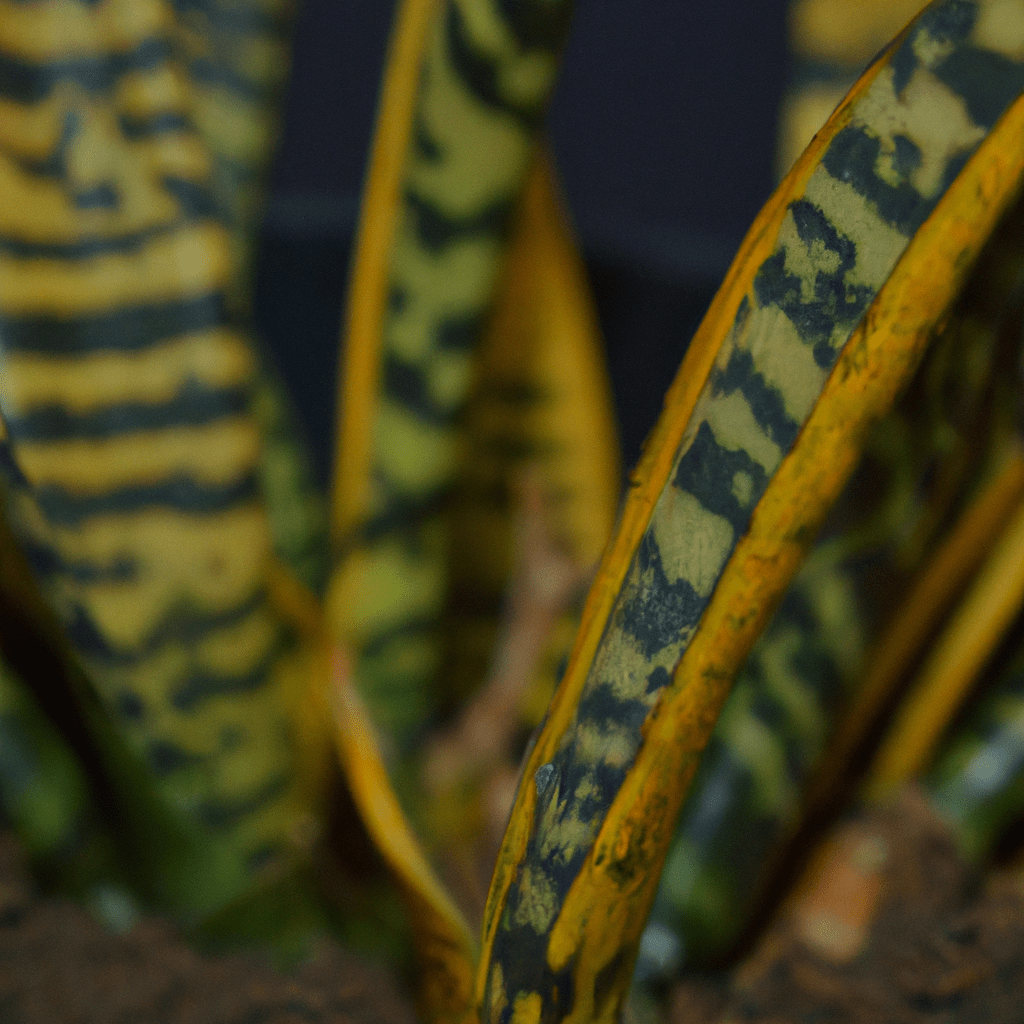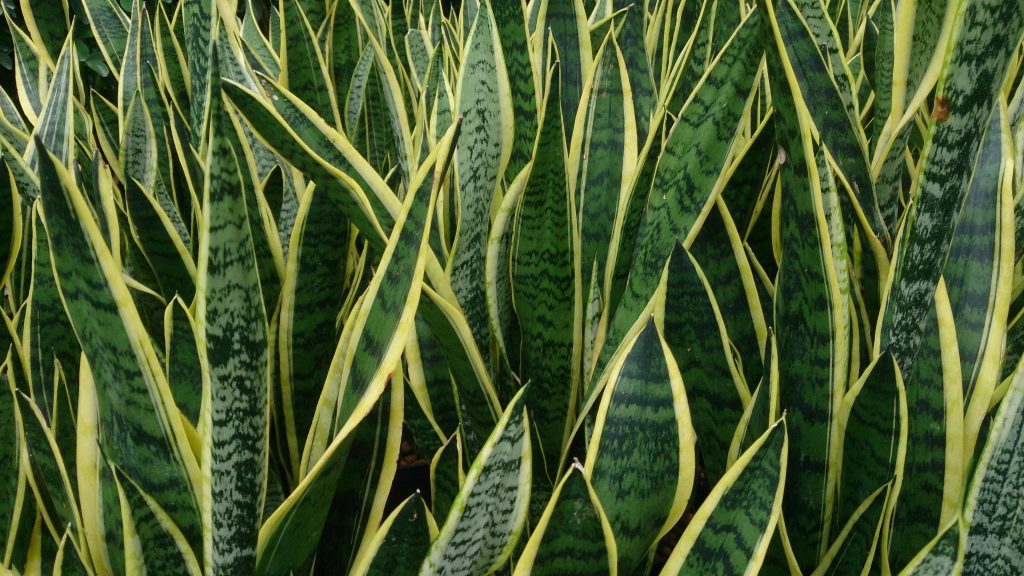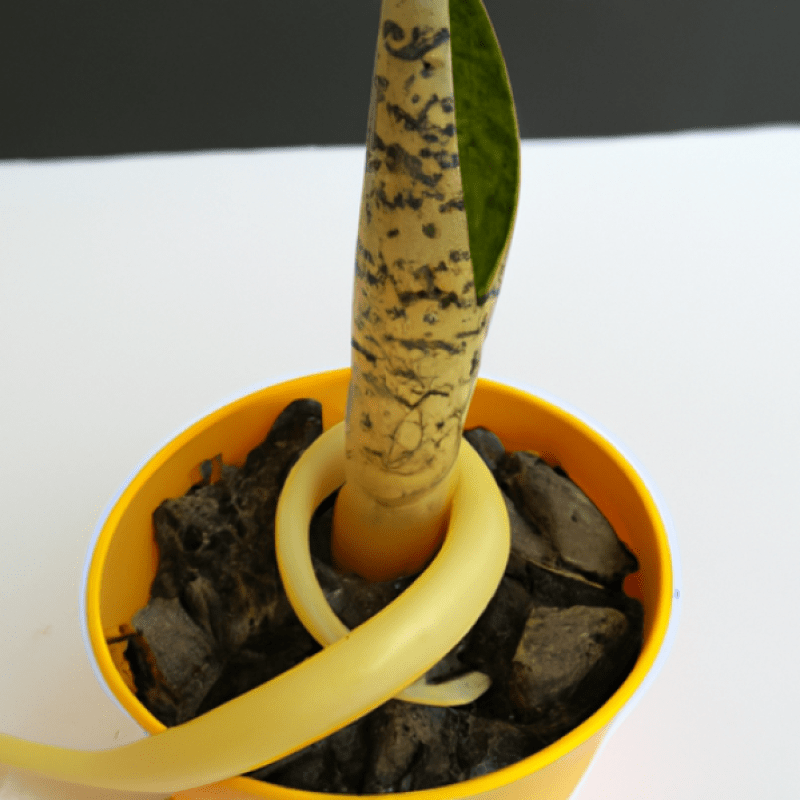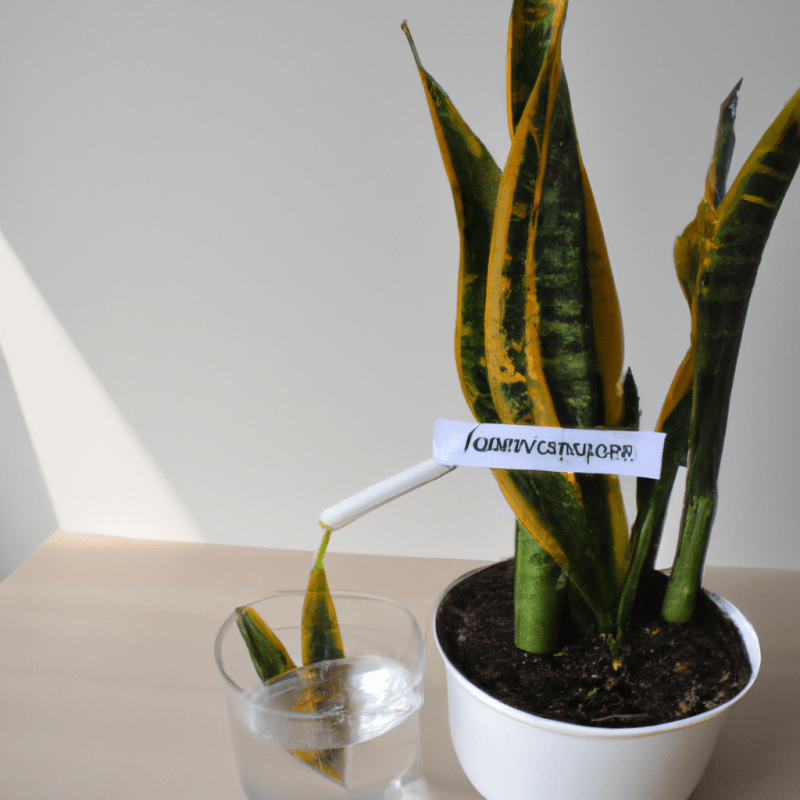Hey there, snake plant enthusiasts! 🌿 Are you a proud owner of the stunning Sansevieria Golden Hahnii? Well, kudos to you! This little beauty is undoubtedly a showstopper with its vibrant golden leaves that can brighten up any space. However, just like any other green buddy, it sometimes encounters a few hiccups along the way. But fear not, my fellow plant parents! In this article, we’re diving into the common problems that our Golden Hahnii might face, so we can protect and pamper them back to health. So buckle up and let’s get ready to decode the secrets of our beloved Sansevieria Golden Hahnii! 🌟
1. How to identify common problems with Sansevieria Golden Hahnii?
Sansevieria Golden Hahnii, also known as Snake Plant or Mother-in-Law’s Tongue, can experience various common problems. Identifying these issues can be challenging but crucial for maintaining plant health. Some common problems to look out for include:
- Overwatering: Excessive moisture can lead to root rot and yellowing of the leaves. Ensure proper drainage and allow the soil to dry between waterings.
- Underwatering: Insufficient watering can cause the leaves to droop and curl. Provide regular watering, ensuring the top inch of soil is dry before watering again.
- Pest infestation: Common pests like mealybugs and spider mites can attack Snake Plants. Look for webbing, white cotton-like masses, or tiny insects. Treat infestations promptly with appropriate insecticides or natural remedies.
- Improper lighting: Insufficient light can result in weak growth and pale leaves, while intense direct sunlight may scorch the leaves. Place the plant in bright, indirect light for optimal growth.
- Fertilizer issues: Over-fertilization can lead to burned leaf tips and root damage. Use a balanced, diluted fertilizer and follow the recommended frequency.
- Temperature stress: Extreme temperatures, especially cold drafts, can cause browning or yellowing of leaves. Maintain the plant in temperatures between 60-85°F (15-29°C).
Remember, actively observing and addressing these common problems will help ensure the vitality of your Sansevieria Golden Hahnii.

2. What causes the leaves of Sansevieria Golden Hahnii to turn yellow?
Sansevieria Golden Hahnii leaves exhibit yellowing due to a myriad of factors that instigate physiological perturbations. These encompass both intrinsic and extrinsic elements which intricately intertwine, further confounding the verdancy of the foliage. Etiological agents such as inadequate water supply, excessive exposure to luminosity, unsuitable ambient temperature, or suboptimal nutrient provision may contribute to this chromatic metamorphosis. Furthermore, pathogenic infestations, specifically those induced by nematodes or fungal infections, and the detrimental impact of abiotic stressors like imbalanced pH or deficient soil drainage, precipitate an accelerated decline in the pigmented vigor of the leaves. To avoid the enigmatic yellowing phenomenon, meticulous attention to the complex interplay of these variables and provision of optimal growing conditions is imperative.
3. How can I prevent root rot in Sansevieria Golden Hahnii?
To prevent root rot in Sansevieria Golden Hahnii, it is crucial to follow certain measures:
1. Well-draining soil: Use a well-draining soil mix that allows excess water to flow away from the roots efficiently. A mix of peat moss, perlite, and sand can help achieve this.
2. Adequate drainage: Ensure the pot has drainage holes to avoid water accumulation at the bottom. Excess water can lead to suffocation of roots and promote rotting.
3. Proper watering: Be cautious not to overwater the plant. Only water when the top inch of the soil is dry, allowing the roots to have access to moisture while avoiding waterlogged conditions.
4. Avoid standing water: Empty any excess water that accumulates in the saucer or tray beneath the pot to prevent the roots from sitting in stagnant water.
5. Suitable pot size: Choose a pot that provides enough space for the roots to grow without being excessive. A pot that is too large can retain too much moisture, increasing the risk of root rot.
6. Temperature and humidity: Ensure the plant is placed in an environment with appropriate temperature and humidity levels. Sansevieria Golden Hahnii thrives in moderate warmth and is more susceptible to root rot in excessively humid conditions.
7. Avoid overfertilization: Do not overfertilize the plant, as excessive nutrients can lead to overgrowth and weaken the roots, making them more prone to rot.
By implementing these preventive measures, you can significantly reduce the likelihood of root rot in Sansevieria Golden Hahnii, promoting a healthier and thriving plant.
4. What is the best way to treat pests on Sansevieria Golden Hahnii?
To effectively treat pests on Sansevieria Golden Hahnii, it is crucial to employ a multi-faceted approach that combines various methods. Firstly, isolate the affected plant to prevent the infestation from spreading to other plants. Next, meticulously inspect the leaves and stems, ensuring to examine the undersides and crevices, where pests often dwell. Employing a magnifying lens,
identify the specific pests infesting the plant. Depending on the type of pest, several treatment options can be pursued:
- Mechanical control: Handpick the pests off the plant or use a strong stream of water to dislodge them.
- Biological control: Introduce beneficial insects, such as ladybugs or predatory mites, which feed on the pests.
- Chemical control: If needed, selectively apply a pesticide specifically formulated for the identified pests. Carefully follow the instructions provided by the manufacturer, ensuring the safety of both the plant and the environment.
Remember to regularly monitor the plant for any reinfestation and take necessary measures promptly to preserve the health and beauty of the Sansevieria Golden Hahnii.

5. Why are the leaves of my Sansevieria Golden Hahnii drooping?
There are several potential reasons for the drooping leaves of your Sansevieria Golden Hahnii:
1. Overwatering: Excessive water accumulation in the soil can lead to root rot, causing the leaves to droop.
2. Underwatering: Insufficient watering can result in dehydration and wilting of the leaves.
3. Light deficiency: Inadequate light can impede photosynthesis, causing weak and droopy leaves.
4. Temperature stress: Extreme temperatures, particularly cold drafts or high heat, can cause leaf drooping.
5. Nutrient imbalance: Lack of essential nutrients or improper fertilization can affect leaf turgidity.
To address this issue, consider adjusting your watering routine, ensuring proper drainage, providing adequate light exposure, avoiding temperature extremes, and maintaining a balanced nutrient regimen. By addressing these potential factors, you can help restore the vitality and vigor of your Sansevieria Golden Hahnii.
6. What should I do if my Sansevieria Golden Hahnii is overwatered?
If your Sansevieria Golden Hahnii has been subjected to excessive watering, immediate action is necessary to rectify this predicament. Firstly, carefully assess the extent of the damage inflicted upon the plant. Inspect the soil meticulously, ensuring it is not excessively damp or waterlogged, as this may perpetuate the adverse effects. Consider implementing the following measures to mitigate the overwatering conundrum:
- Cease watering: Immediately halt any further watering to prevent exacerbating the situation.
- Enhance drainage: Relocate the plant to a well-draining container or amend the soil with substances such as perlite or coarse sand to ameliorate drainage.
- Moderate moisture: Allow the soil to partially dry out before resuming watering, ensuring it is not kept consistently moist.
- Prudent pruning: If root rot is apparent, trim away affected roots and any visibly damaged foliage.
- Optimal environment: Provide the plant with adequate light and ensure it is situated in a well-ventilated area to expedite drying.
Implementing these remedial actions should aid in recuperating your Sansevieria Golden Hahnii from the perils of overwatering, fostering its rejuvenation and restoring its overall vitality.
7. Are there any specific diseases that affect Sansevieria Golden Hahnii?
Sansevieria Golden Hahnii is susceptible to several diseases that can hinder its growth and overall health. These specific diseases include:
- Root Rot: Excessive watering or poorly drained soil can lead to root rot in Sansevieria Golden Hahnii. This fungal disease causes the roots to decay, resulting in yellowing leaves, wilting, and ultimately, plant death.
- Leaf Spot: Leaf spot diseases, caused by various fungal pathogens, can affect Sansevieria Golden Hahnii. Infected leaves develop small, irregular-shaped spots that may be brown, black, or yellow. These spots can coalesce, leading to leaf discoloration, necrosis, and eventually defoliation.
- Mealybugs and Spider Mites: These common pests can infest Sansevieria Golden Hahnii, sucking sap from the leaves and causing stunted growth and yellowing. Mealybugs are identified by their white, cottony appearance, while spider mites create fine webbing on the plant and cause speckled discoloration.
- Bacterial Soft Rot: This bacterial disease can affect the fleshy leaves of Sansevieria Golden Hahnii, causing them to become waterlogged, slimy, and mushy. It often occurs due to excessive moisture, poor air circulation, or wounds on the plant.
To ensure the optimal health of Sansevieria Golden Hahnii, it is important to provide proper care, including well-draining soil, controlled watering, and regular inspection for pests.
8. How do I maintain the health of my Sansevieria Golden Hahnii?
To maintain the health of your Sansevieria Golden Hahnii, it is essential to follow certain care guidelines. Firstly, ensure you provide the plant with the right light conditions—bright indirect light is optimal, but it can tolerate low light as well. Next, water the plant moderately, allowing the soil to dry out between waterings. Overwatering can lead to root rot and adversely affect its health. Regularly check the soil’s moisture level by inserting your finger into the soil. Additionally, fertilize the plant sparingly during the growing season, using a balanced houseplant fertilizer. Sansevierias are relatively low-maintenance, but occasional repotting may be necessary when the plant becomes root-bound. Finally, be cautious of cold temperatures, as they can harm the plant. By adhering to these guidelines, your Sansevieria Golden Hahnii can thrive and maintain its health.
9. Can Sansevieria Golden Hahnii tolerate direct sunlight or shade?
Sansevieria Golden Hahnii showcases a remarkable capacity to endure both direct sunlight and shade, surviving with unyielding determination. This resilient succulent displays an uncanny ability to adapt and thrive, transcending the boundaries of light exposure with its robust nature. As if defying conventional expectations, it embraces the scorching rays of the sun and retreats to the comforting embrace of shadow without faltering. It flourishes in a realm where the intensity of sunlight and the depths of shade intertwine, making it an enigmatic marvel to behold.
10. What is the recommended temperature range for Sansevieria Golden Hahnii?
The recommended temperature range for Sansevieria Golden Hahnii is between **50°F (10°C) and 85°F (29°C)**. This intriguing plant thrives in an environment that experiences moderate fluctuations in temperature, stimulating its growth and enhancing its leaf coloration. However, it can withstand brief exposure to temperatures slightly outside this range, adding an unpredictable element to its adaptability. It is important to note that extreme temperature variations may impede the development of this enigmatic species, rendering its survival skills somewhat enigmatic as well.
And there you have it, folks! We’ve uncovered the top common problems that can plague our beloved Sansevieria Golden Hahnii. But fear not, dear plant enthusiasts, for knowledge is power, and now armed with these insights, you can conquer any obstacle that comes your way!
Remember, when it comes to your Golden Hahnii, prevention is key. Keep those watering habits in check, give it plenty of light, and avoid overfeeding. And if you notice any unwelcome visitors like spider mites or mealybugs, don’t panic! A little bit of TLC and a trusty neem oil solution will have your plant looking vibrant and healthy once again.
So, fellow green thumbs, go forth and be the plant whisperers you were born to be. Let’s let our Sansevieria Golden Hahnii thrive and bring a touch of golden elegance to our homes. And if you encounter any troubles along the way, just remember, you’ve got this! Happy planting!



